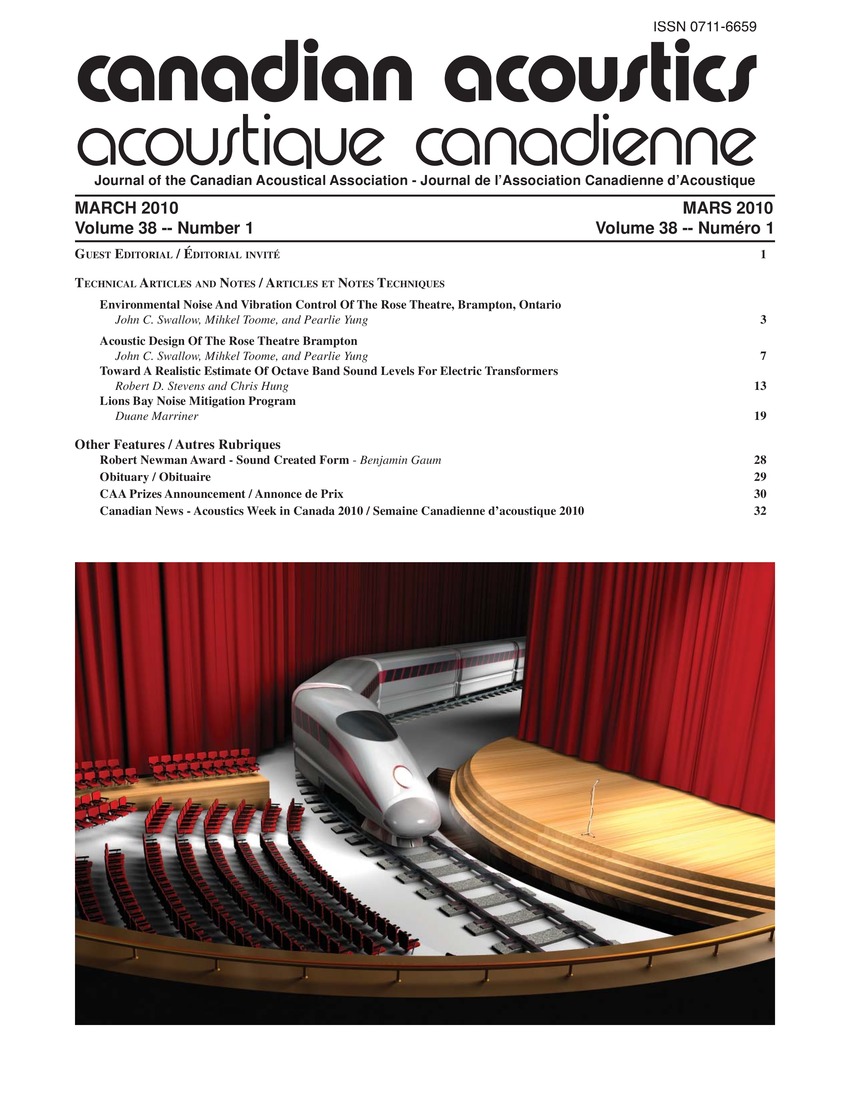Acoustic design of the Rose Theatre Brampton
Keywords:
Architectural acoustics, Climate control, Light sources, Reflection, Reverberation, Testing, Acoustic design, Brampton, HVAC system, MathCAD, Orchestra pit, Reflected light, Reflected sounds, Reverberation time, Road shows, Sound level, Test procedures, Wall surfacesAbstract
The Rose Theatre, Brampton is a community theatre of 930 seats intended for most types of performances including drama, musical theatre, road shows and the Brampton Symphony The theatre breaks convention by locating the Mix booth at the centre of the orchestra thus putting the Mixer out where he can hear what the audiences hears. The house is horseshoe-shaped and features one balcony, tiered seating, a full 45ft width (13.7m) Broadway style proscenium opening, an orchestra pit on a lift and a full catwalk level above the balcony. The deep Proscenium was used to direct energy from stage in the apron area as lateral reflections to seating. Variable acoustics were accomplished with curtains which retract into pockets which when extended cover the rear wall of the audience seating and the wall surface above the catwalk level. A MathCAD routine to calculate the strength and location of reflections from convex reflectors was used on the proscenium reflectors and five sets of linear ceiling reflectors. The HVAC system was designed for RC20. A novel test procedure was developed for checking the aiming of the reflectors where a light source was aimed at the acoustic reflectors. The reflected light, simulating a reflected sound wave, could then be seen illuminating a portion of the audience area indicating the aiming of the reflector. The background sound level and reverberation time measurements confirmed the background sound level of RC 20 and reverb time ranging from 1.1 to 1.5 sec. Measurements of uniformity of sound in the house showed a variation of +/- 2 dB throughout the dress circle and balcony seating. The Auditorium is described by both performers and patrons as very intimate.Additional Files
Published
How to Cite
Issue
Section
License
Author Licensing Addendum
This Licensing Addendum ("Addendum") is entered into between the undersigned Author(s) and Canadian Acoustics journal published by the Canadian Acoustical Association (hereinafter referred to as the "Publisher"). The Author(s) and the Publisher agree as follows:
-
Retained Rights: The Author(s) retain(s) the following rights:
- The right to reproduce, distribute, and publicly display the Work on the Author's personal website or the website of the Author's institution.
- The right to use the Work in the Author's teaching activities and presentations.
- The right to include the Work in a compilation for the Author's personal use, not for sale.
-
Grant of License: The Author(s) grant(s) to the Publisher a worldwide exclusive license to publish, reproduce, distribute, and display the Work in Canadian Acoustics and any other formats and media deemed appropriate by the Publisher.
-
Attribution: The Publisher agrees to include proper attribution to the Author(s) in all publications and reproductions of the Work.
-
No Conflict: This Addendum is intended to be in harmony with, and not in conflict with, the terms and conditions of the original agreement entered into between the Author(s) and the Publisher.
-
Copyright Clause: Copyright on articles is held by the Author(s). The corresponding Author has the right to grant on behalf of all Authors and does grant on behalf of all Authors, a worldwide exclusive license to the Publisher and its licensees in perpetuity, in all forms, formats, and media (whether known now or created in the future), including but not limited to the rights to publish, reproduce, distribute, display, store, translate, create adaptations, reprints, include within collections, and create summaries, extracts, and/or abstracts of the Contribution.


